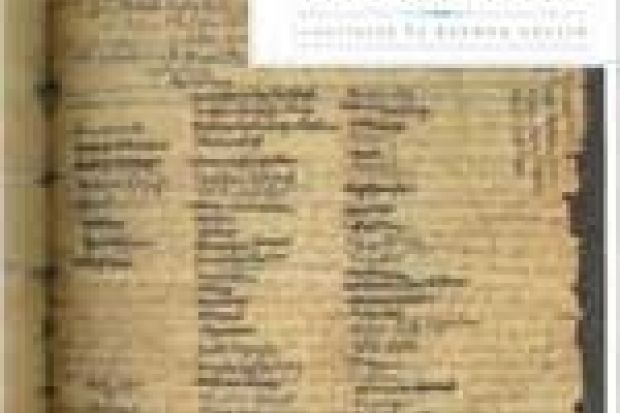Walter Benjamin's Archive provides access in English to the catalogue of an exhibition mounted at the Berlin Academy of Arts at the end of 2006. In 13 chapters, with beautifully reproduced facsimiles, it gives insight into Benjamin's often idiosyncratic interests and working methods. The Walter Benjamin Archive, now in Berlin, holds three groups of his manuscripts, working papers and personal effects: those that Benjamin salvaged when he fled from Paris in 1940, the material for the Arcades project hidden by Georges Bataille in the Bibliotheque Nationale and the papers seized by the Gestapo in Paris and sent by the Red Army to Moscow, whence they made their way via the German Democratic Republic to Frankfurt. Although Benjamin is now widely read in the world of cultural studies and European philosophy, the hermetic nature of much of his writing makes this glimpse of the tangible residue of a life, its working patterns and private fascinations, an attractive prospect.
Photographs of Russian peasant toys, Benjamin's evident delight in the physical form of his notebooks and his careful registration of linguistic inventiveness as his son Stefan learnt to talk all suggest a scholarly curiosity that ranged across every aspect of his experience. Yet although these photographs and facsimiles seem to bring us very close to the man, his papers and even his collection of postcards present crucial resistances. The final sections of the catalogue, reflecting Benjamin's enthusiasm for riddles and word games and presenting his postcards of the sibyls from the floor of Siena cathedral, bring the problem to a head - if not to a conclusion. As Erdmut Wizisla recognises in his introduction to these samples from Benjamin's collection, the eloquent verbal imagery of rebus and riddle exactly corresponds to Benjamin's thinking, the architectural organisation of his writings and the graphic form of his manuscripts.
This is nowhere clearer than in the manuscripts and notes presented under the title "From small to smallest details: micrographies". A single page of the early expose of the Arcades project crams 81 lines of minuscule writing on to a folded page yielding a writing surface of 22cm by 9.5cm. Benjamin's preference, most of the time, for German blackletter handwriting (Sutterlin) makes reading even more an act of decipherment. And the microscopic hand is not reserved for personal use. Private letters and manuscripts of poems, such as When I Start a Song, are also committed to the tiniest script (though it is one of the inconsistencies of this English version that the facsimiles are even smaller than in the German catalogue, and unlike that volume give no indication of the degree to which the actual image has been reduced). The very gesture of Benjamin's writing is designed to resist easy assimilation and exploitation.
The same impulse is evident in the attention Benjamin lavished on his notebooks: alongside a diary, travel journals, notes for future work, sketches and outlines of letters, Benjamin maintained a running register of books he had read. It falls to Wizisla once again to introduce the cult that Benjamin promoted around his notebooks, the quality of their paper and their leather bindings. What is apparent in Benjamin's obsessive attention to such detail, just as in his micrographism, is a determination to resist any easy access to his work via the medium of print and the book trade - even by himself. In this respect, his habits of mind and the way he went about writing are reminiscent of Karl Kraus's pernickety obsession with grammar and punctuation and the doggedly uncommercial methods of Die Fackel.
The notebooks, the minuscule hand, like the collections of postcards, photographs and toys, rescue Benjamin's own thought and its occasions, perhaps even his life, from excessive availability. Like the popular puzzles and riddles Benjamin wrote about in an essay titled "What our grandparents racked their brains over", and which he tried his hand at himself in a number of manuscripts reproduced here, his notebooks retain as aesthetic objects a personal mystery corresponding to the critical distance sought by his thinking.
What becomes clear is that jottings and fragments, gathered in notes and notebooks and rearranged in alternate sequences and outlines, constitute the very processes of Benjamin's critical imagination. His careful archival approach to his own material not only preserved material for his scholarly historical and philosophical investigations; the archive was itself the site of that work.
Walter Benjamin's Archive is a treasure trove of curios and enigmas that display a mind at work and in play. One of its great advantages over the German edition is the provision, in many cases, of translations of texts on facing pages. Esther Leslie's translation is heroic in giving versions of Stefan Benjamin's endless neologisms, and beyond this is generally usable. But too often it is inelegant, obscure and even downright inaccurate.
Walter Benjamin's Archive
Edited by Ursula Mars, Gudrun Schwarz, Michael Schwarz and Erdmut Wizisla, translated by Esther Leslie
Verso
312pp
£16.99
ISBN 9781844671960
Published 4 February 2008
Register to continue
Why register?
- Registration is free and only takes a moment
- Once registered, you can read 3 articles a month
- Sign up for our newsletter
Subscribe
Or subscribe for unlimited access to:
- Unlimited access to news, views, insights & reviews
- Digital editions
- Digital access to THE’s university and college rankings analysis
Already registered or a current subscriber? Login




